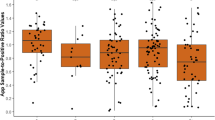Abstract
Increased risk of high Yersinia enterocolitica 0:3 and 0:9 antibody content has been previously reported in occupations with swine contact. In this study several possible confounders of this elevated risk among pig farmers and abattoir workers were considered. Only in three instances the standardized risk ratio was decreased close to unity, namely after the standardization of Y. enterocolitica 0:3 IgG antibody positivity for age among abattoir workers, after the standardization of Y. enterocolitica 0:9 IgG antibody positivity for farm butchering among pig farmers and for smoking among abattoir workers. As the decrease did not apply for both pig farmers and abattoir workers and for both 0:3 and 0:9 serotypes considered, it seems reasonable to assume that the three decreases represent products of multiple testing inherent in this kind of search of confounders rather than any true effects. In view of the present knowledge on the determinants of yersinia antibodies in populations, the crude risk ratios for elevated yersinia antibodies can be held to be reasonably unconfounded.
Similar content being viewed by others
References
Aldova E. and Svandova E. (1984): Yersinia enterocolitica 03 findings on porcine tongues in comparison with Yersinosis incidence in man in Czechoslovakia - J. Hyg. Epidemiol. Microbiol. Immunol. 28: 319–329.
Asplund K., Tuovinen V., Veijalainen P., Hirn J. (1990): The prevalence of Yersinia enterocolitica 0:3 in Finnish pigs and pork - Acta Vet. Scand. 31: 39–43.
Christensen S.G. (1987): The Yersinia enterocolitica situation in Denmark - Contr. Microbiol. Immunol. 9: 93–97.
Cover T.L. and Aber R.C. (1989): Yersinia enterocolitica - N. Engl. J. Med. 321: 16–24.
Fukushima H., Nakumura R., Ito Y. and Saito K. (1983): Ecological studies of Yersinia enterocolitica. I. Dissemination of Y. enterocolitica in pigs - Vet. Med. 112: 469–483.
Granfors K. (1979): Measurement of immunoglobulin M (IgM), IgG and IgA antibodies against Yersinia enterocolitica by enzyme-linked immunosorbent assay: Persistence of serum antibodies during disease- J. Clin. Microbiol. 9: 336–341.
Granfors K., Lahesmaa-Rantala R., Stahlberg Th., Toivanen A. (1989): Comparison of bacteria with and without plasmid-encoded proteins as antigens for measurement of immunoglobulin M, G, and A antibodies to Yersinia enterocolitica by enzyme-linked immunosorbent assay - J. Clin. Microbiol. 27: 583–585.
Hunter D. and Hughes S. (1983): Isolation of Yersinia enterocolitica from pigs in the United Kingdom - Vet. Rec. 112: 332–333.
Kolos E.N., Gnutov I.N., Iushenko S.V. and Dunaev V.I. (1985): Agricultural animals as the sources of Yersinosis - Zh. Microbiol. Epidemiol. Immunobiol. 4: 77–80.
Langeland G. (1983): Yersinia enterocolitica and Yersinia enterocolitica-like bacteria in drinking water and sewage sludge - Acta Path. Microbiol. Immunol. Scand., Sect. B, 91: 179–185.
Lassen J. (1972): Yersinia enterocolitica in drinking-water- Scand. J. Infect. Dis. 4: 125–127.
Merilahti-Palo R., Lahesmaa R., Granfors K., Gripenberg-Lerche C. and Toivanen P. (1991): Risk of yersinia infection among butchers - Scand. J. Infect. Dis. 23: 55–61.
Miettinen O.S. (1985): Theoretical epidemiology - 1st ed. New York: John Wiley & Sons: 370–372.
Nesbakken T., Kapperud G., Lassen J. and Skjerve E. (1991): Yersinia enterocolitica 0:3 antibodies in slaughterhouse employees, veterinarians, and military recruits - Contrib. Microbiol. Immunol. 12: 32–39.
Seuri M. and Granfors K. (1992): Antibodies against Yersinia among farmers and slaughter house workers- Scand. J. Work Environ. & Health 18: 128–132.
Tauxe R.V., Vandepitte J., Wauters G., Martin S.M., Goossens V., De Mol P., VanNoyen R. and Thiers G. (1987): Yersinia enterocolitica infections and pork; the missing link - Lancet 1: 1129–1132.
Wauters G. (1979): Carriage of Yersinia enterocolitica serotype 3 by pigs as a source of human infection -Contrib. Microbiol. Immunol. 5: 253–256.
Author information
Authors and Affiliations
Additional information
Corresponding author.
Rights and permissions
About this article
Cite this article
Seuri, M., Granfors, K. Possible confounders of the relationship between occupational swine contact and Yersinia enterocolitica 0:3 and 0:9 antibodies. Eur J Epidemiol 8, 532–538 (1992). https://doi.org/10.1007/BF00146372
Issue Date:
DOI: https://doi.org/10.1007/BF00146372




